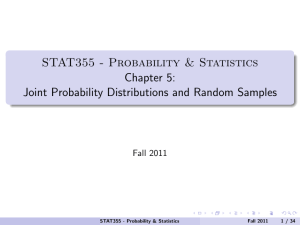x 0 1 2 otherwise
advertisement
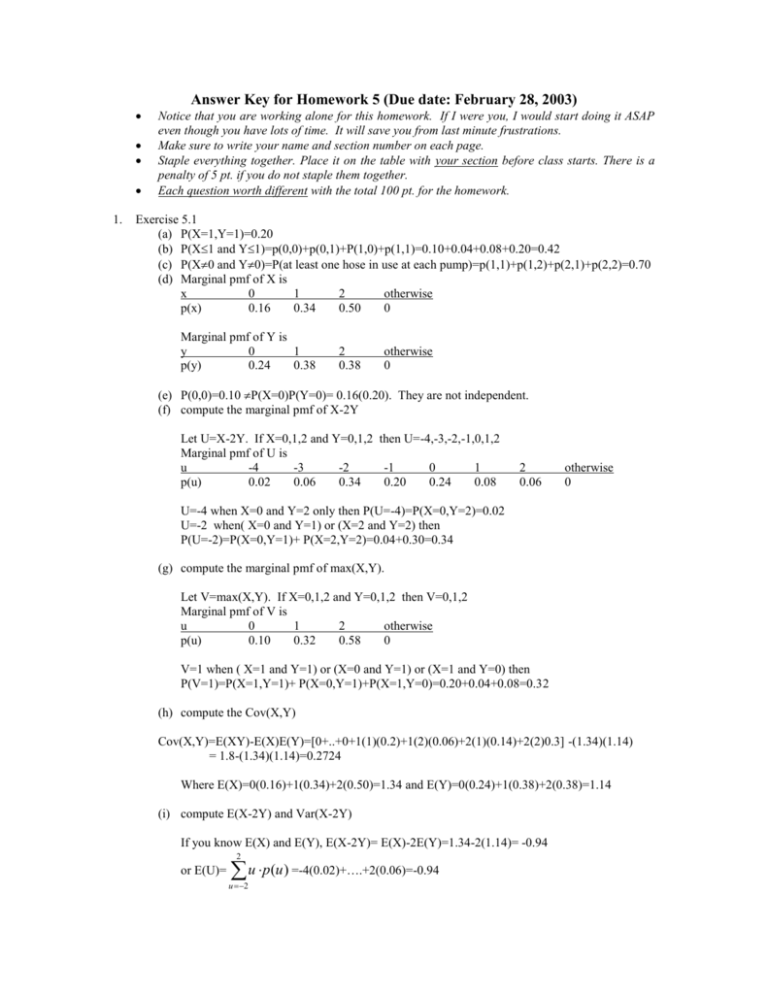
1. Answer Key for Homework 5 (Due date: February 28, 2003) Notice that you are working alone for this homework. If I were you, I would start doing it ASAP even though you have lots of time. It will save you from last minute frustrations. Make sure to write your name and section number on each page. Staple everything together. Place it on the table with your section before class starts. There is a penalty of 5 pt. if you do not staple them together. Each question worth different with the total 100 pt. for the homework. Exercise 5.1 (a) P(X=1,Y=1)=0.20 (b) P(X1 and Y1)=p(0,0)+p(0,1)+P(1,0)+p(1,1)=0.10+0.04+0.08+0.20=0.42 (c) P(X0 and Y0)=P(at least one hose in use at each pump)=p(1,1)+p(1,2)+p(2,1)+p(2,2)=0.70 (d) Marginal pmf of X is x 0 1 2 otherwise p(x) 0.16 0.34 0.50 0 Marginal pmf of Y is y 0 1 p(y) 0.24 0.38 2 0.38 otherwise 0 (e) P(0,0)=0.10 P(X=0)P(Y=0)= 0.16(0.20). They are not independent. (f) compute the marginal pmf of X-2Y Let U=X-2Y. If X=0,1,2 and Y=0,1,2 then U=-4,-3,-2,-1,0,1,2 Marginal pmf of U is u -4 -3 -2 -1 0 1 p(u) 0.02 0.06 0.34 0.20 0.24 0.08 2 0.06 otherwise 0 U=-4 when X=0 and Y=2 only then P(U=-4)=P(X=0,Y=2)=0.02 U=-2 when( X=0 and Y=1) or (X=2 and Y=2) then P(U=-2)=P(X=0,Y=1)+ P(X=2,Y=2)=0.04+0.30=0.34 (g) compute the marginal pmf of max(X,Y). Let V=max(X,Y). If X=0,1,2 and Y=0,1,2 then V=0,1,2 Marginal pmf of V is u 0 1 2 otherwise p(u) 0.10 0.32 0.58 0 V=1 when ( X=1 and Y=1) or (X=0 and Y=1) or (X=1 and Y=0) then P(V=1)=P(X=1,Y=1)+ P(X=0,Y=1)+P(X=1,Y=0)=0.20+0.04+0.08=0.32 (h) compute the Cov(X,Y) Cov(X,Y)=E(XY)-E(X)E(Y)=[0+..+0+1(1)(0.2)+1(2)(0.06)+2(1)(0.14)+2(2)0.3] -(1.34)(1.14) = 1.8-(1.34)(1.14)=0.2724 Where E(X)=0(0.16)+1(0.34)+2(0.50)=1.34 and E(Y)=0(0.24)+1(0.38)+2(0.38)=1.14 (i) compute E(X-2Y) and Var(X-2Y) If you know E(X) and E(Y), E(X-2Y)= E(X)-2E(Y)=1.34-2(1.14)= -0.94 2 or E(U)= u p(u ) =-4(0.02)+….+2(0.06)=-0.94 u 2 If you know Var(X),Var(Y) and Cov(X,Y) then, Var(X-2Y)= Var(X)+4Var(Y)-4Cov(X,Y)=[2.34-1.342]+4[1.9-1.142]-4(0.2724)=1.8564 2 or E(U2)= u 2 p(u ) =(-4)2(0.02)+….+22(0.06)=2.74 then Var(U)=2.74-(-0.94)2=1.8564 u 2 (j) compute the conditional pmf of Y given X=0 P(Y=y | X=0)=P(0,y)/0.16 = 0.10/0.16= 0.625 = 0.04/0.16= 0.25 = 0.02/0.16= 0.125 =0 when y=0 when y=1 when y=2 otherwise 2. Exercise 5.2 (a) If X and Y are independent, the joint probabilities can be computed by P(x,y)=P(x)P(y) for all x and y. x 0 1 2 y 0 0.30 0.18 0.12 1 0.05 0.03 0.02 2 0.025 0.015 0.01 3 0.025 0.015 0.01 4 0.10 0.06 0.04 (b) P(X1,Y1)=p(0,0)+P(0,1)+p(1,0)+p(1,1)=0.56 (c) P(X+Y=0)=P(X=0,Y=0)=0.30 (d) P(X+Y1)= p(0,0)+P(0,1)+p(1,0)=0.53 3. Exercise 5.9 . (a) x3 2 K ( x y ) dxdy K 20 20 20 3 xy 380000 K 1 3 30 30 30 2 2 30 30 3 dy K 19000 10 y 2 dy K 19000 y 10 y 3 3 3 20 20 20 30 then K=3/380000 (b) x3 P( X 26, Y 26) K ( x y )dxdy K xy 2 3 20 20 20 26 26 26 2 2 26 dy K 9576 6 y 2 dy 3 20 20 26 26 9576 y3 114912 K 114912 K y 6 0.3024 3 20 3 380000 3 30 x 2 (c) P( X Y 2) 1 28 30 2 2 K ( x y )dydx 22 20 K (x 20 x 2 2 y 2 )dydx =0.3593 30 2 y3 19000 30 K 10 x 2 (d) f(x)= K ( x y )dy K x y x 2 0.05 3 20 3 380000 20 30 2 2 where 20x30 30 2 x3 19000 30 K 10 y 2 (e) f(y)= K ( x y )dx K y x y 2 0.05 3 20 3 380000 20 30 2 2 where 20x30 then f(x,y)f(x)f(y) . X and Y are not independent. (f) First compute Cov(X,Y)=E(XY)-E(X)E(Y)=641.4474-25.329(25.329)=-0.1082 30 30 x 4 x2 30 2 where E(X)= xf ( x)dx x x 0.05 dx 0.05 380000 380000 4 2 20 20 30 = 25.329 30 30 x 5 x3 30 E ( X ) x f ( x)dx x x 2 0.05 dx 0.05 3 20 380000 380000 5 20 30 2 2 2 = 649.825 30 30 y 4 y2 30 and E(Y)= yf ( y )dy y y 2 0.05 dy 0.05 380000 2 20 380000 4 20 30 = 25.329 30 30 y 5 y3 30 2 E (Y ) y f ( y )dy y y 0.05 dy 0.05 3 20 380000 380000 5 20 30 2 2 2 = 649.825 x4 x2 3 E(XY)= xy( K ( x y )) dxdy K y y 4 2 20 20 20 30 30 30 2 2 dy 20 30 30 y2 y4 250 =81250000K=641.4474 K 162500 y 250 y dy K 162500 2 4 20 20 30 3 then Corr(X,Y)= Cov( x, y ) Var ( X ) Var (Y ) 0.1082 649.825 25.329 2 649.825 25.329 2 = -0.0131 (g) compute the conditional pdf of X given Y=y f(x|y)= f ( x, y ) f ( y) K (x2 y 2 ) 3( x 2 y 2 ) where 20y30 19000 (30 y 2 19000) 2 K 10 y 3 4. Exercise 5.41 (a) _ _ x possible pairs (1,1) (1,2),(2,1) (1,3),(3,1),(2,2) (1,4),(4,1),(2,3),(3,2) (3,3),(2,4),(4,2) (3,4),(4,3) (4,4) 1 1.5 2 2.5 3 3.5 4 P( x ) 0.4(0.4)=0.16 2(0.4)(0.3)=0.24 2(0.4)(0.2)+0.3(0.3)=0.25 2(0.4)(0.1)+2(0.3)(0.2)=0.20 0.2(0.2)+2(0.3)(0.1)=0.10 2(0.2)(0.1)=0.04 0.1(0.1)=0.01 _ (b) P( x 2.5)=0.16+0.24+0.25+0.20=0.85 (c) R possible pairs 0 (1,1),(2,2),(3,3),(4,4) 1 (1,2),(2,1),(2,3),(3,2),(3,4),(4,3) 2 (1,3),(3,1),(2,4),(4,2) 3 (1,4),(4,1) 5. P(R) 0.4(0.4)+0.3(0.3)+0.2(0.2)+0.1(0.1)=0.30 2(0.4)(0.3)+2(0.3)(0.2)+2(0.2)(0.1)=0.40 2(0.4)(0.2)+2(0.3)(0.1)=0.22 2(0.4)(0.1)=0.08 Exercise 5.59 (a)(c) (a) E(X1+X2+X3)=60+60+60=180 and Var(X1+X2+X3)=15+15+15=45 then 200 180 =P(Z2.98)=0.9986 45 150 180 200 180 Z =P(-4.47Z2.98) P(150X1+X2+X3200)= P 45 45 P(X1+X2+X3200)= P Z =0.9986-0=0.9986 (c) E(X1-0.5X2-0.5X3)=60-0.5(60)-0.5(60)=0 and Var(X1+X2+X3)=15+(0.5)215+(0.5)215=22.5 10 0 then P(-10 X1-0.5X2-0.5X35)= P =0.8531-0.0174=0.8357 22.5 Z 50 =P(-2.11Z1.05) 22.5

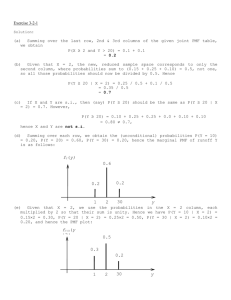
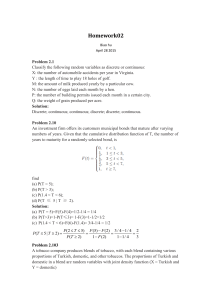

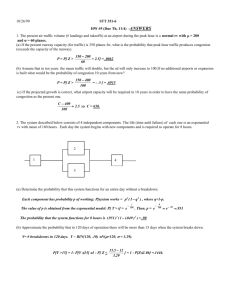
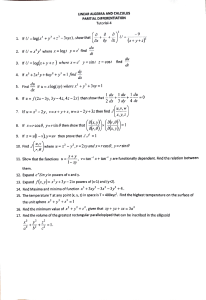

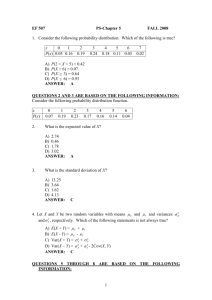

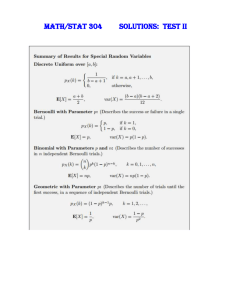


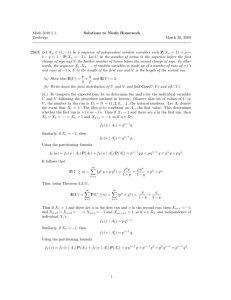

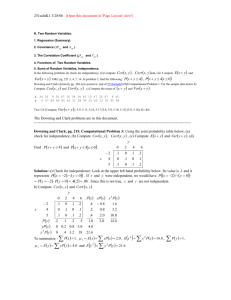
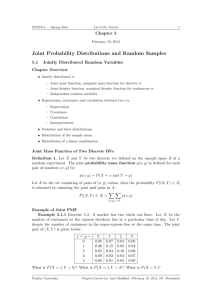
![Stat 110 notes - {m x[a}w n g]](http://s3.studylib.net/store/data/008120387_1-3b4895d2f473dfe516b6ab16119e31f2-300x300.png)
